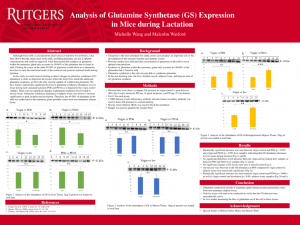Wang, Michelle: Analysis of Glutamine Synthetase (GS) Expression in Mice during Lactation
Title: Analysis of Glutamine Synthetase (GS) Expression in Mice during Lactation
Name: Michelle Wang
Major: Biochemistry
School affiliation: School of Environmental and Biological Sciences
Programs: Aresty – Research or Conference Funding Recipient
Other contributors: Malcolm Watford
Abstract: Although breast milk is considered the ideal source of nutrition for newborns, it has been shown that the amino acids in the milk, including glutamine, are not at optimal concentrations and could be improved. It has been found that synthesis of glutamine within the mammary gland only accounts for 50-60% of the glutamine that is found in milk. Finding the source of the other 40-50% of glutamine would allow us to determine how best to meet the nutritional needs of the newborn and promote maternal health during lactation.
In this study, we used western blotting to detect changes in glutamine synthetase (GS) abundance in order to determine the tissues within the body from which the additional glutamine originates, as GS is the only enzyme capable of synthesizing glutamine. We have found a statistically significant decrease in glutamine synthetase abundance in liver tissue during early and peak lactation (PD6 and PD16) as compared to the virgin control samples. There were no significant changes in glutamine synthetase levels found in muscle tissue. Glutamine synthetase abundance in adipose tissue was shown to increase significantly at peak lactation and involution. Therefore, the 40-50% of glutamine in the milk not synthesized in the mammary gland possibly comes from non-mammary adipose tissue.
